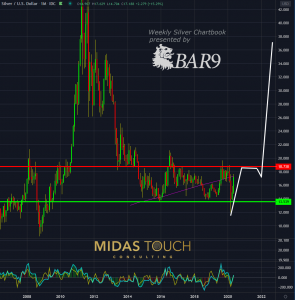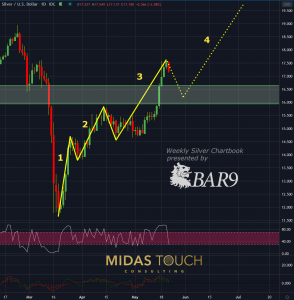May 21st 2020, Silver Chartbook – Wrong data wrong results
Wrong data wrong results
In the previous century, if you wanted to be an independent market player you either worked yourself up on the floor of an exchange or had a professional trader as a mentor. Then market participation got expanded towards the internet. You still had to spend thousands of dollars for live trading courses, books and videos to acquire some fundamental knowledge. However, today the whole body of trading educational materials is vast. Education is readily available, yet one thing has changed. New traders aren’t willing to spend the money for a solid education. It is believed that all data is available for free on the internet. Trading is a very visual art form requiring charts. This makes YouTube the main information data provider for self educators. Here however, principle based data gets lost! We are not referring to the quality of date. We want to point out wrong data wrong results
The false lure
Algorithms on YouTube for their sidebar selections aren’t programmed on the basis of clicks. Meaning, once you search for a specific topic, you do not get rated references of other related products offered in the sidebar. YouTube has complex algorithms that are based only on one goal: maximizing the customers view time. You watch a dog video you simply get more dog videos offered. This in the hopes you are not changing platforms but rather continue watching for extended time videos on YouTube.
The result is that you might seek information on a specific analysis technique and try to learn if this approach is useful or not. But you end up becoming a fanatic about your specific choice of interest since all you get offered is an endless array of the same content. The mere volume of the same content feels like a confirmation that you have found the holy grail.
Silver, Weekly Chart: Wrong Data Wrong Results
The weekly chart above shows the last trade we executed on silver. The entry setup was posted ahead of time in our weekly chartbook. (Entry 5/1/20 at US$14.73, Financing target 5/7/2020 at US$15.25, First target 5/11/2020 at US$15.60, Final target 5/18/2020 at US$17.25)
All entries and exits were posted live in our free telegram channel. We used our quad exit strategy. The final target produced a return of 17.11% in less than three weeks time.
When self educating, it is helpful to model people who provide simple but precise data. Core principles of market behavior have not changed throughout time. Consequently release date of a book or technique is of no influence to its value. If anything, older materials can be more often principle based.
Most educators try to brand their teachings by renaming standard patterns to their own classifications which does nothing else but confuse and delude. Trading is already an art form meaning chart interpretation is tricky and not precise. As such precision in the rudimentary principles and basic commonalities is essential. Only then you can expand from there to create true edges!
We encourage to read core materials even if these books do not come cheap.
Here are our Top 5 books for beginners:
- Mark Douglas – Trading In The Zone
- Edwin Lefèvre – Reminiscences of a Stock Operator
- Van Tharp – Peak Performance Course for Traders & Investors
- Jack Schwager – Market Wizards: Interviews with Top Traders
- Ari Kiev – Mastering Trading Stress
We also invite all new traders to ask questions in our free Telegram channel. Without clarity on what makes markets move, a new market participant finds him- or herself in a house without any solid foundation and as such quickly under a collapsing roof.
Silver, Monthly Chart: Range Versus Direction
The monthly chart above shows how silver prices have faster than usual cut through their typical sideways range (US$13.50 to US$18.75). This allows for speculation that a range break to the upside has a higher probability than the usual approach of the US$18.75 resistance zone. Especially as “V” shaped recoveries have a high likelihood to temporarily trade sideways and advance in their direction after a brief dip.
Range versus direction
This is one of the absolute core questions rarely answered. Seeing clearly if a market is ranging or in a trend seems an easy task but eludes most. It determines more than 70% of ones trading rules. Anticipating range breaks or trend reversals determines if indicators or oscillators are to be used. It is also the decisive factor which exits and entries are valid to be executed. One rarely finds this addressed in modern YouTube videos. Principle based answers to this core question are an essential asset for the astute market participant.
Silver, Daily Chart: Wrong Data Wrong Results – Keep it simple
The daily chart above shows an entry opportunity coming up to add to larger time frame positions. With a directional move in play and three legs up so far, a retracement here is a possibility. This would allow for an entry for a final 4th blow off leg.
As of right now we find long term ownership of silver and gold to be the most valuable asset of wealth preservation. This does not require in depth knowledge of advanced low time frame trading principles. A top down approach in time frame is essential.
One of the main problems with trading is the fact, that it is counter intuitive.
It isn’t technical analysis that is the core of financial success. It is psychology and money management. New market participants are lured by holy grail offers, mathematical solutions to beat the game, and an endless array of false promises of all sorts. The typical route of a new trader is underestimating the time necessary to find an edge in the markets. He embarks on a multiyear focus on creating a good entry strategy. The logic behind is simply that entries come first. Truth of the matter is that it is exits that determine profitability much more. And as pointed out, psychology and money management supersede that by far. In the light of this, a business plan is the basic foundation of a good starting point.
Wrong data wrong results
The less educated crowd of new market participants has always been lining the pockets of the professionals. The learning curve has been always a steep and costly one in this specific profession. Easy access with the simple push of a button on a computer was a lure at the turn of the century. It allowed access to the money of the masses. There to be quite a difference between a lure and pure manipulation.
In today’s world it isn’t even talked about anymore that trading is a profession. Consequently requiring in depth knowledge, time and education. Millennial’s are burdened with an expectation to be millionaires before the age of 25. Operating systems have switched from alphabetic searching to manipulated swiping on screens. The underlying intent is subconscious branding and sales. Algorithms reroute our choices. You still falsely belief to have a library at your feet. In the end, there is nothing wrong with watching YouTube videos as long as you don’t think that spending money on trading education is stupid and reading is only for old folks. Just be careful by using YouTube´s sidebar to not get dragged down the rabbit hole!


